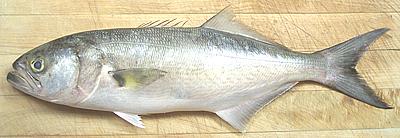 [Tailor (Australia); Shad (East South Africa); Elf (West South Africa);
Anchova (Brazil, Portugal); Enchova (Brazil); Anchoa, Anjova (Spanish);
Pomatomus saltatrix]
[Tailor (Australia); Shad (East South Africa); Elf (West South Africa);
Anchova (Brazil, Portugal); Enchova (Brazil); Anchoa, Anjova (Spanish);
Pomatomus saltatrix]
This fish is found in tropical and subtropical waters all around the world, except the northern, central and eastern Pacific Ocean. I don't know what it has against the Pacific, but it doesn't live there. It can grow to 51 inches and 31 pounds but the photo specimen was 16-1/4 inches and weighed 1.5 pounds.
Bluefish is the only member of family Pomatomidae. It had a near relative off the coast of Southern California, but that fish has been extinct for 5 million years. Bluefish is a voracious eater and apparently kills more fish than it can eat. It is fierce when caught and often bites (its teeth are really sharp). This fish has been overfished, but controls have restored populations off North America and some other regions. Considered a good eating fish, it's a highly commercial catch in some regions, particularly Turkey and Brazil, and is now being farmed.
More on Varieties of fish (very
large page).
Bluefish flesh is a medium color and distinctly flavored but not nearly as strong as mackerel. There is a narrow dark strip down the centerline of the fillet which has a stronger flavor but that can easily be removed if your taste in fish is, umm . . . "refined".
Fillets can be cooked by any method and hold together well but flake apart easily on the plate. The flesh is very tender when raw but cooks up quite firm, though not objectionably firm. I consider this an excellent eating fish.
I particularly like fillets lightly dusted with rice flour and pan fried in a neutral flavored oil. This fish has sufficient flavor not to be overwhelmed by this method of cooking.
Buying: This fish sometimes appears in the Asian fish markets here in Los Angeles. It's not a fish you can just go out and buy, it's a fish you buy when you see it.
Scales: This fish is covered with smallish and rather thin scales that are easy to scrape off and don't fly around much as you do so.
Fillet: Bluefish is fairly easy to fillet with a bone structure that is easy to follow. Fillet gently, because the flesh is very tender and flakes apart easily when raw. There will be substantial centerline pin bones for the first 1/4 of the fish. Use your long nose pliers to pull them out, straight forward.
Skin: The skin shrinks quite a bit when fried but this isn't the easiest fish to skin. The flesh is tender and the skin is also thin and tender. Use care, and expect a few fragments of skin remaining on the fillets - they do no harm. See our standard long knife and cutting board Method.
Yield: A 1-1/2 pound fish yielded 12 ounces of skinless fillet (50%).
Stock: The head, fins and bones make a medium flavored stock quite usable for soup. For details see our recipe Making Fish Stock.
sf_bluez 060915 - www.clovegarden.com